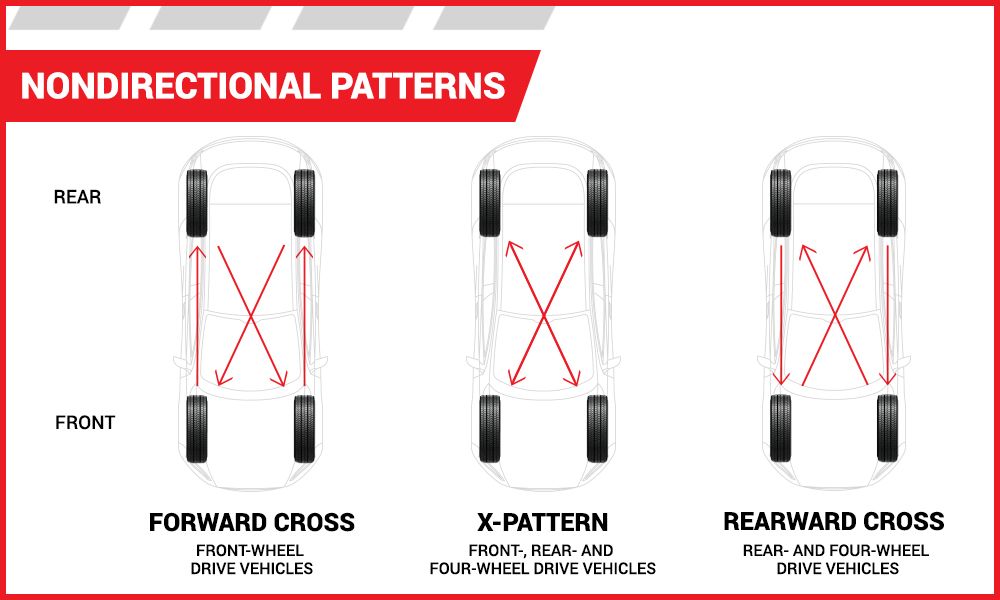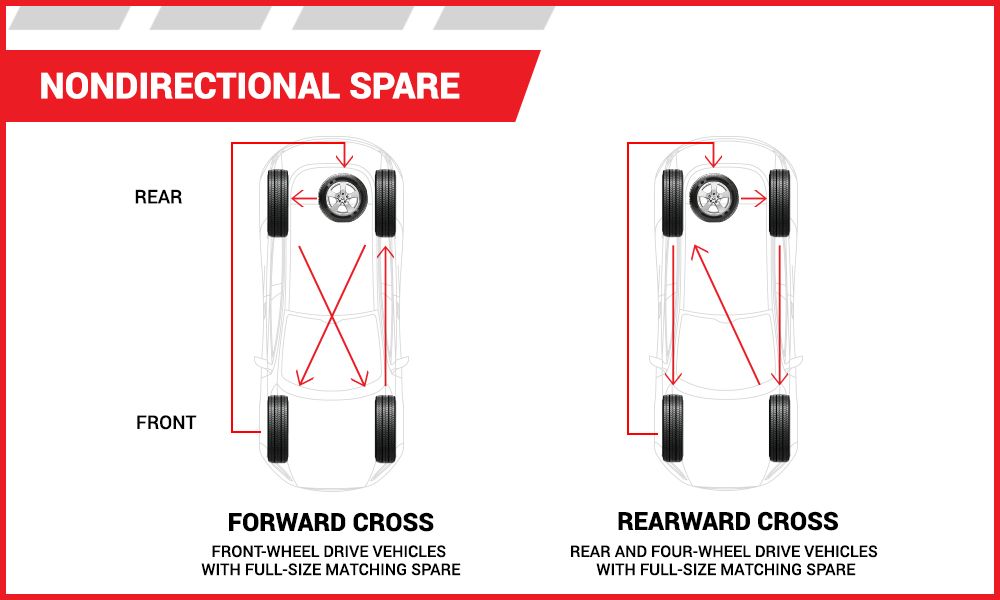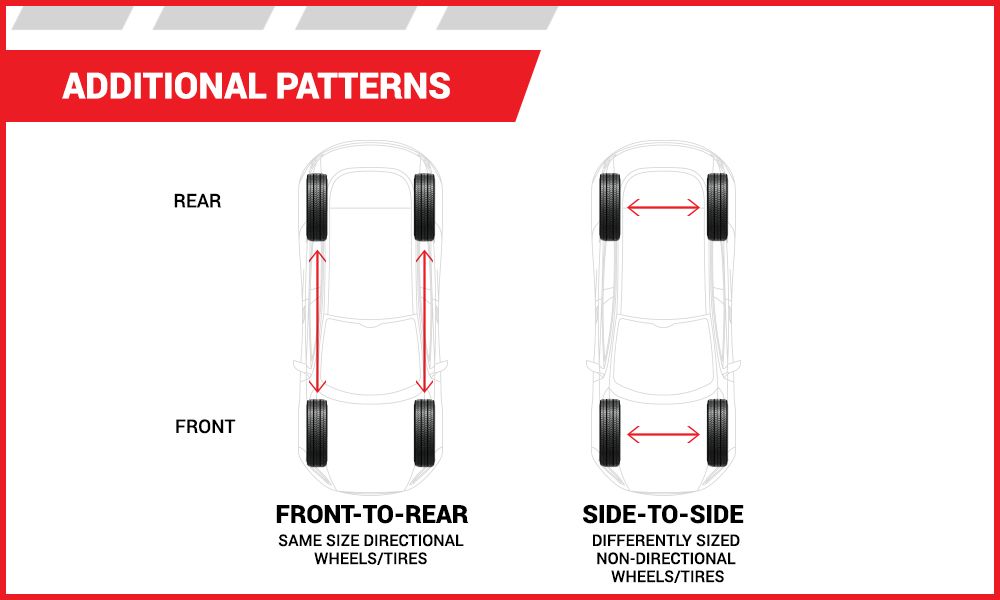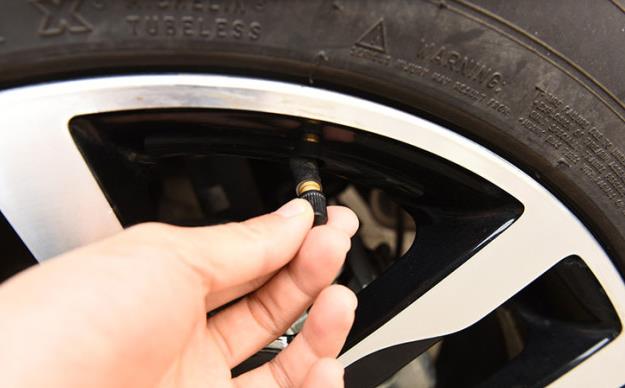Tire Rotation: Get in the Habit and Learn the Patterns
Tire rotation might not always be top of mind. You may never even think about it, but remembering to rotate your tires regularly does, in fact, matter quite a bit. Just like your standard oil changes, routine tire rotation isn't hard, and it isn't too time-consuming. Rotating your tires plays a big part in keeping you safe and in keeping money in your pocket.
What is Tire Rotation?
Let's start with the basics. The term "tire rotation" refers to the process of switching out the placement of your tires, as they are mounted on your vehicle, to help maintain an even tread and prolong their life.
In other words, you're rotating the position of your tires on your vehicle — whether you're switching them out from front to back, from left to right, diagonally or otherwise. These different tire positions are known as tire rotation patterns , and we'll get into the specifics of those later on.
Why Rotating Your Tires Matters
Think of tire rotation as any other type of standard or preventative maintenance on your car, such as an oil change or an alignment check.
Did you know that your vehicle's tires wear differently? Although it may seem like each tire wears the same as you're driving along every day, there are many factors that contribute to uneven wear. For example, one little-known fact is that your front tires typically carry more than 60 percent of your vehicle's weight, causing them to wear down faster than your rear tires. The simple act of turning your vehicle right or left also contributes to uneven wear.
You also need to consider whether your vehicle is a front-wheel drive, rear-wheel drive, all-wheel drive or four-wheel drive. Each performance mechanism causes the vehicle's tires to wear differently. The tasks you ask your vehicle to perform every day — whether you're ascending mountains, sitting in stop-and-go traffic or cruising for hundreds of miles on the freeway — contribute greatly to the how your tires wear.
After thousands of miles of driving, no matter how you ask your vehicle to perform, some wear is inevitable. Rotating the position of your tires on your vehicle equalizes these natural wear patterns, helping ensure a smoother, safer ride for you and your family.
And if safety isn't reason enough for you to commit to regular tire rotation, perhaps money is. We all know that tires aren't cheap. When you habitually rotate your tires, you're balancing out your tread, which will save you big money on tire replacement in the long run. In fact, most tire warranties require regular tire rotation to keep the warranty valid, so this simple maintenance will keep you worry free in that regard.
When to Rotate Your Tires
When considering when to rotate your tires, you'll hear different numbers from different people, but a good rule of thumb to abide by is every 3,000 to 5,000 miles — even if there are no visible signs of wear. Of course you can never go wrong by following the recommended rotation intervals listed in your vehicle's owner's manual.
Treat regular tire rotation as preventative maintenance, and get it done every time you're in for an oil change. So, seize the moment and save yourself some time, hassle, and money (in the long run).
Rotating Your Own Tires
If you're feeling super ambitious — or if you don't want to spend the extra money to have a professional rotate your tires for you — it's always possible to do it yourself. Keep in mind that you will need at least 20 minutes and that you'll have to invest in a good car jack and jack stands if you don't already own them.
Once you've determined the correct rotation pattern for your vehicle (see the next section), rotating your own tires is more a matter of time and physical ability than anything else. Here's a very high-level how-to guide for you to follow:
Make sure your car is parked on a level surface.
Engage the parking brake to ensure your safety.
Next, loosen the lug nuts on all of your wheels, but don't remove them completely.
Then use your car jack to elevate one wheel, place a jack stand under it and remove the tire.
Follow this sequence with each of the other tires and rearrange them according to the best rotation pattern for your vehicle. Finally, carefully follow the steps above in reverse order.
Tire Rotation Patterns
The number of tire rotation patterns can be confusing and overwhelming, so make sure to consider where you'll be moving each tire before you decide to take on the task of rotating them yourself.
Your specific rotation pattern depends on whether you have directional or nondirectional tires; staggered fitment (differently sized) tires; a full-size or mini spare tire; and front-wheel, rear-wheel, four-wheel or all-wheel drive. If you're unsure of what pattern to use, be sure to check your vehicle's owner's manual or the industry standards for your vehicle.
Note: If your vehicle has staggered fitment or differently-sized directional tires on the front and rear, those tires will need to be dismounted from the wheels, and remounted and balanced on the opposite wheels.



























